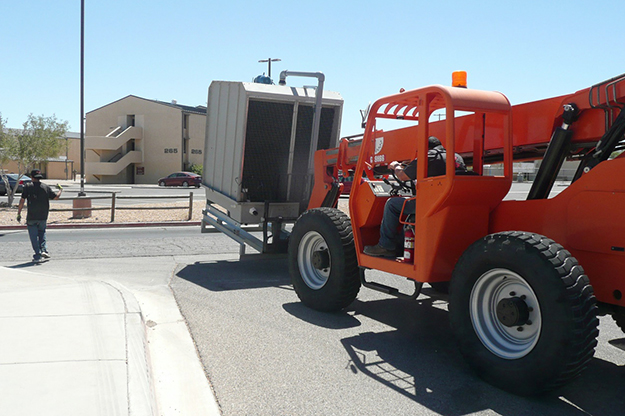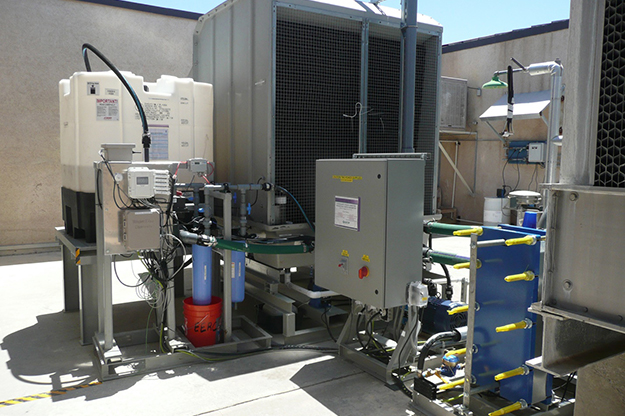Cool technology
UND’s EERC receives $1.8 million from Department of Defense to demo water-saving technology

When most people think of the U.S. Department of Defense (DoD), they probably don’t think of its huge office buildings or barracks first.
Chris Martin, the UND Energy & Environmental Research Center’s senior research engineer for advanced thermal systems, has been thinking about DoD’s buildings a lot lately and about all the water used to cool them.
Martin developed new technology to address building cooling water consumption and was recently selected by DoD for a $1.8M award over the next three years to demonstrate the technology.
This project is focused on improving the trade-off between water consumption and cooling efficiency in DoD’s wet cooling towers, which use large amounts of water to dissipate heat from various processes including building heating, ventilation, and air conditioning (HVAC) loads; data center cooling; power generation; and other industrial purposes.
The proprietary cooling technology is designed to optimize water use so that the benefits of wet evaporative cooling can be applied during hot summer afternoons, but the needless evaporation of water can be curtailed when cooler conditions allow efficient and sensible heat transfer to the air.
The Department of Defense is the largest consumer of energy in the federal government, spending billions of dollars each year to power its military installations around the world. DoD is estimated to have 4,000+ conventional wet cooling towers at its facilities, and each tower is a significant consumer of water. For example, one desert-based cooling tower at Ft. Irwin (one of the test sites for this project) has been estimated to consume up to 2.6 million gallons of water annually and produce almost 1.5 million gallons of concentrated wastewater for disposal.

A mission-critical resource
Water is a mission-critical resource that is scarce in many parts of the country. As threats to water and other energy resources increase, DoD’s energy planning is key to ensuring successful missions in the future.
Cooling towers are a common component of on-base infrastructure, and the sheer number of installed units suggests significant opportunity for technology replication across DoD if this technology is determined to be a cost-effective strategy to reduce water consumption.

Martin’s project involves field-testing two demonstration units at sites that are characterized by “hot, dry” and “moderate but humid” summer weather. Both sites are in California, but represent two extremes.
Ft. Irwin National Training Center in the Mojave Desert is among the most water-stressed facilities in the country. Out of necessity, it will need to be an early adopter of water-conserving technology. The second location, DoD Center Monterey Bay in Seaside, Calif., represents a moderate coastal California climate but it’s a location where water quality and availability are a concern, since the local supply relies on fragile groundwater aquifers. Combined results from Fort Irwin and Seaside will be extrapolated to estimate performance across the country, including the hot and humid southeast United States, home to many DoD facilities that might face increased water stress in the future.
“The underlying hypothesis of this new cooling technology is that savings in water consumption over time can result in a lower life cycle cost than with conventional wet cooling, which has a lower initial investment cost,” said Martin. To validate this hypothesis, the EERC will look at water savings, cooling efficacy, and operational costs over a yearlong trial.
The new cooling technology stems from prior work at the EERC, including projects funded by the U.S. Department of Energy (DOE) National Energy Technology Laboratory and DOE’s Advanced Research Projects Agency—Energy (ARPA-E) to develop a large-scale dry cooling alternative for thermoelectric power plants, which are the single largest users of fresh water in the United States.
“Reducing the intensity of water use during cooling will save money in the form of reduced operating costs, preserve limited fresh water for other purposes, and also enhance the security and resiliency of DoD’s mission by buffering critical operations like indoor environmental control from the unpredictable future of water availability and cost,” said Martin.


